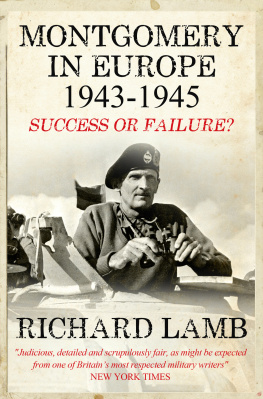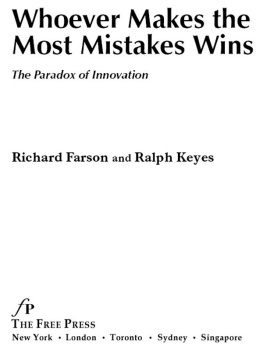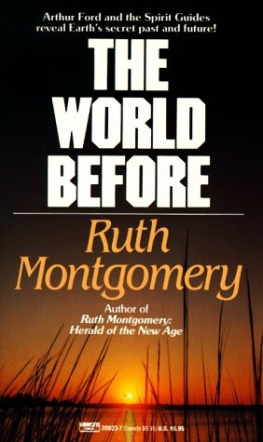Montgomery in Europe 1943-45
Success or Failure?
Richard Lamb
Richard Lamb 1999
Richard Lamb has asserted his rights under the Copyright, Design and Patents Act, 1988, to be identified as the author of this work.
First published in 1983 by Buchan and Enright Publishers Ltd.
This edition published in 2017 by Endeavour Press Ltd.
Table of Contents
Good-morning; good-morning! the General said
When we met him last week on our way to the line.
Now the soldiers he smiled at are most ofem dead,
And were cursing his staff for incompetent swine.
Hes a cheery old card, grunted Harry to Jack
As they slogged up to Arras with rifle and pack.
*
But he did for them both by his plan of attack.
Siegfried Sassoon, The General
Foreword
Field-Marshal the Viscount (Bernard) Montgomery of Alamein was the best known and the most controversial general of the Second World War. Under the thirty-year rule his archives in the Public Record Office were made available to historians six years ago, and only a short period remains while those close to him during the war will be available to comment on the secrets disclosed sadly, many are already dead. Surprisingly, no work of military history based upon these documents has so far been published. This is therefore an appropriate moment to write a study of his generalship in Europe from 1943 to 1945, when he fought his most important campaigns, using these key fresh documents and other archives, as well as the views of those close to him during the period.
In some ways I found it easier to write about Napoleon than Montgomery. Both commanders wrote a great number of letters and orders each day during their campaigns. Napoleons are all collected and in print; Montgomerys are scattered. Meanwhile, members of my own generation who took part in his campaigns are becoming fewer, and I had much looked forward to meeting and discussing Montgomerys conduct of these battles with Maj-Gen Sir Kenneth Strong, KBE, CB, and Maj-Gen R.F.K. (David) Belchem, CB, CBE, DSO. Alas, they have both died since I embarked on this work, although both left behind valuable books.
Although Montgomery for most of his life had little interest in money, he caught the publishing itch with the success of his post-war books, and in 1962 sold his diaries and personal papers to the Sunday Times for a capital sum and an annuity. In this archive there may be some documents relating to his campaigns, as well as to his personal life, of importance to military historians. No date has been fixed for their release, and meanwhile those of us who knew about and took part in the Second World War are growing older.
I have thus not read Montgomerys so-called diary for the period covered by this book. I have not missed much. Lt-Col Christopher (Kit) Dawnay,* who was Montgomerys Military Assistant from shortly after the Normandy landings until the end of the war, told me that his general was too busy to write a daily diary. Instead he instructed Dawnay to keep a series of Twenty-First Army Group files giving a description of the main events and Montgomerys reasons for his decisions; the result was known as the Log. Dawnay had frequent conferences with his commander on what to insert and how to phrase it, but the whole record was in fact written by Dawnay in the third person. In addition, these files contain duplicates of important letters written by Montgomery and Eisenhower, and of key directives.
There were at least six copies of the Log, and the Prime Minister, the Chief of the Imperial General Staff, and the Secretary of State for War were each sent one. There are copies in the Dawnay archives, in Churchill College, Cambridge, and in the Public Record Office. At other periods of his life Montgomery wrote a daily diary, but for the North-West Europe campaign his diary probably consists of inserts added after the war to the Log kept by Dawnay. Extracts referred to as diary entries in his post-war books do not correspond exactly with the Log.
Brigadier Sir Edgar (Bill) Williams, Montgomerys head of Intelligence, helped his chief with his memoirs, and rewrote substantial chunks from drafts in the Field-Marshals own handwriting. Normally, Bill Williams told me, Montgomery would accept his alterations, but when there were queries he would never produce his sources. According to Williams, Montgomerys diaries would tend to show history as he would like it to be written, not as it actually was. Williams continued: My chief interest in the Montgomery diaries when they are eventually released would be to see what boasts Montgomery made about events in which he and I were intimately involved together. Kit Dawnay told me that Montgomery always wanted the Log written to show events as he liked to view them in retrospect.
* He was Montgomerys G (Ops) officer at Twenty-First Army Group Tac HQ, and was in charge of the liaison officers and the whole of Tac HQ.
The Eighth Army files for the period I have covered are reasonably complete, but the Twenty-First Army Group files have been ravaged; I suspect that the Field-Marshal was partially responsible. After all, Winston Churchill, when Prime Minister after the war, gave Montgomery virtual approval when he defended him for keeping the original Liineburg surrender document. In the House of Commons Churchill refused to take complaints about this liberation seriously, saying: If such trophies became the personal property of the Commander-in-Chief in the field it would be an incentive to all young officers in the British Army. He went on to tell the late Dick Stokes, Labour MP for Ipswich, that if he (Stokes) had secured the surrender of half a million enemies he could keep the receipt for the transaction, but I can assure the House there is no chance of anything like that happening CHansard, 17.6.1954, Col. 2277).
Fortunately, however, I have found the key records missing from the Twenty-First Army Group archives by searching in the files of other British formations and of SHAEF at the PRO, or in American archives and other archives at home.
I have unearthed a great number of Montgomerys letters and notes, mostly in his own handwriting. I have quoted copiously from these both because they reveal him as a man, and because they give the background to his often crucial decisions far better than his own post-war writing and speeches. His letters, notes and orders written in the heat of battle show dramatically his frame of mind at the time, and the considerations behind his actions and decisions.
His sometimes inflammatory correspondence with Eisenhower, much of which I have reproduced, demonstrates the at times bitter hostility between them. These internecine quarrels threatened the Anglo-American alliance, and the enmity between Twenty-First Army Group and the War Office, on the one hand, and SHAEF on the other, has never been fully underlined before. I have not taken sides, but have produced the facts for the reader to make his own judgement on the controversy. Nevertheless, I feel that the contrast between Montgomerys clear views on how the war should be conducted and Eisenhowers compromise and lack of decision emerges very clearly from their letters.
I give my sincere thanks to David Montgomery, the present Viscount, for his kindness and his valuable help, and for permission to quote from his fathers writings. He has been good enough to say that he welcomes this book.
Bill Williams is a very old friend of mine: We were both at Merton College, Oxford, as undergraduates fifty years ago, and it was a very small college then. It has been for me a great pleasure to resume our friendship, and the help he has given has been beyond value. He was close to Montgomery throughout the period I have covered and, with his acute academic mind and his experience in editing the Dictionary of National Biography , his comments have been most illuminating. I have included many quotations from Williams as they reveal much about Montgomery and the other British and American commanders; he has also been kind enough to read much of the manuscript.










